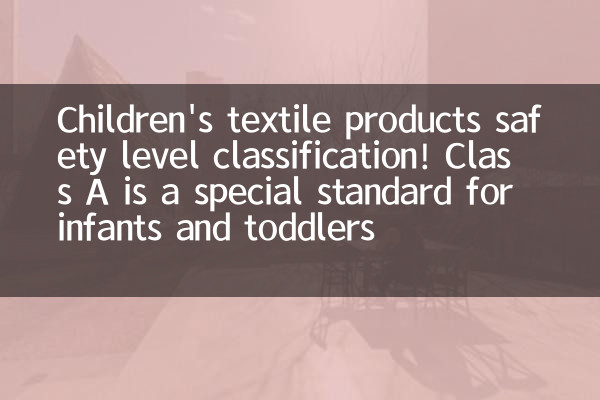Children's textile products safety level classification! Class A is a special standard for infants and toddlers
In recent years, the safety of children's textile products has attracted much attention from parents. With the strengthening of the national quality supervision of children's products, the classification of safety grades of textile products has become an important basis for consumers to purchase. This article will revolve aroundChildren's textile products safety levelExpand the analysis and combine the popular topics on the entire network for the past 10 days to provide parents with scientific purchasing guides.
1. Standards for safety grade classification of children's textile products

According to the national mandatory standard "GB 31701-2015 Safety Technical Specifications for Infant and Child Textile Products", children's textile products are divided into the following three categories according to safety requirements:
| Safety Level | Applicable age | Main requirements |
|---|---|---|
| Class A | Infants and toddlers under 36 months | Formaldehyde content ≤20mg/kg, pH value 4.0~7.5, no carcinogenic dyes, flame retardant performance meets the standard |
| Class B | Children over 3 years old | Formaldehyde content ≤75mg/kg, pH value 4.0~8.5, some indicators are looser than Class A |
| Class C | Indirect contact skin products | Formaldehyde content ≤300mg/kg, other requirements are further relaxed |
2. Hot topics in the past 10 days: inventory of children's textile safety incidents
1.Carcinogens were detected in a certain brand of children's clothing: A children's T-shirt marked as "pure cotton" was detected to have a banned azo dye, which has caused parents to worry about the quality of products on the online shopping platform.
2.Class A standard penetration rate is insufficient: The State Administration for Market Regulation random inspection showed that some infant and toddler clothing sold in offline stores did not clearly mark the safety level, which was misleading consumption.
3.New environmentally friendly materials attract attention: Children's clothing made of natural materials such as organic cotton and tinsel have become a hot topic on social media, and the search volume of related products has increased by 65% year-on-year.
3. Parental purchasing guide
1.Identify the label information: Qualified products must be marked with safety category (A/B/C), implementation standards (GB 31701), fiber composition and other information.
2.Priority to select Class A products: Even if the child is over 3 years old, the higher safety of Class A products is still worthy of priority.
3.Beware of "three no" products: The quality problems exposed recently are mostly concentrated on cheap goods without tags and factory names.
4. Industry development trend data
| index | 2023 data | Year-on-year growth |
|---|---|---|
| Market share of Class A products | 58% | 12% |
| Children's textile complaints | 23,000 pieces | -8% (restriction strengthened) |
| Functional textile requirements | UV protection/antibacterial species account for 37% | twenty one% |
Conclusion
Children's textile safety concerns the healthy growth of the next generation, and parents need to pay attention to it when purchasing.Class A standard certification, it is also recommended to choose a regular channel to purchase. With the increase in national quality inspection efforts and the improvement of consumer awareness, the children's textile market will continue to upgrade to higher safety standards in the future.
(The full text is about 850 words in total, and the data statistics cycle is: the latest public information in 2023)

check the details

check the details